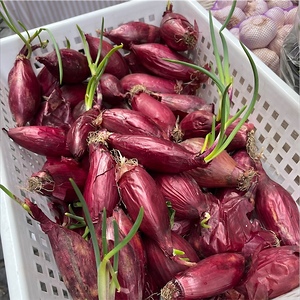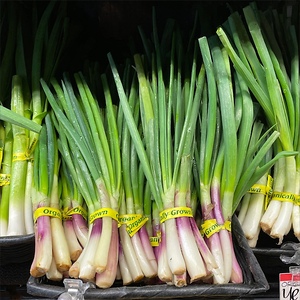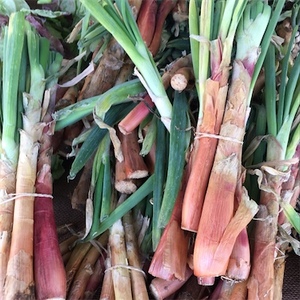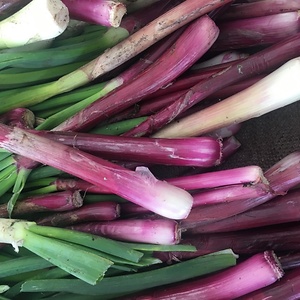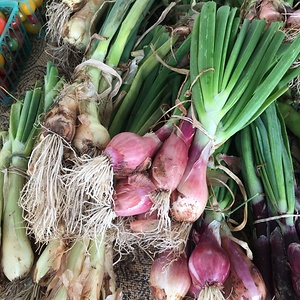

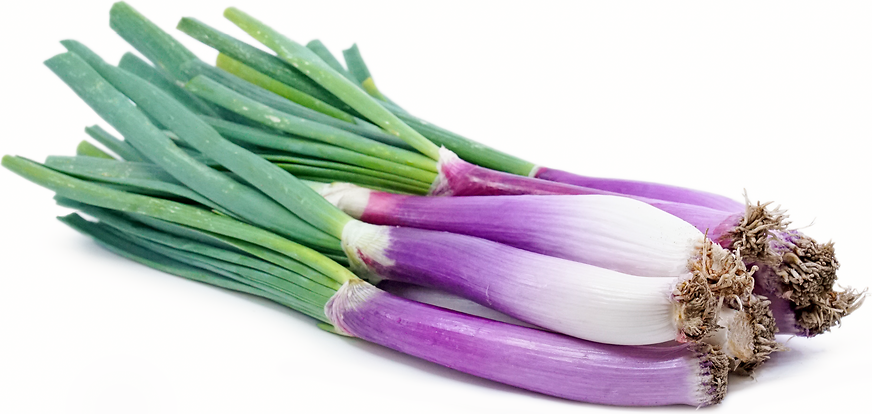
Red Calcot Onions
Estimated Inventory, 8 lbs : 0
Description/Taste
Red Calcot onions are small to medium in size, averaging 15-25 centimeters in length and 2-3 centimeters in diameter, and are elongated, slender, and cylindrical in shape. Appearing similar in shape to a green onion or a young leek, Red Calcot onions have a smooth, juicy, and crisp, white base with small root-like hairs protruding from the base. The white base then transitions into a deep red-purple, and the dark green stalk at the top of the base is pliable, slightly stringy, and hollow. Red Calcot onions are mild and sweet when raw and when cooked, they become extremely tender and develop a smoky, slightly sweet flavor.
Seasons/Availability
Red Calcot onions are available in the winter through spring.
Current Facts
Red Calcot onions, botanically a part of the Amaryllidaceae family, is a general name for onions that are produced from a specific growing technique. Originally from Spain, this method is known as calçar, a Catalan agricultural term which means to cover the trunk of a plant or vegetable with soil. Red Calcot onions are grown from bulbs that were allowed to remain dormant from the previous season and are replanted the following late summer. As the stalks grow, they are covered with dirt to keep the base white and to elongate the shoots. When the stalks are harvested, they are often covered in a thin layer of dirt, and this dirt is kept on during the cooking process to provide a barrier between the open flame and onion. Red Calcot onions are favored for their sweet flavor and tender texture and are traditionally celebrated during the spring season in Spain at food festivals dedicated to the onion.
Nutritional Value
Red Calcot onions contain some vitamin C, vitamin B6, calcium, manganese, flavonoids, and potassium.
Applications
Red Calcot onions are best suited for both raw and cooked applications such as grilling and can be used as a substitute in recipes calling for green onions or spring onions. The onions are most commonly flash blanched and then grilled until charred, creating savory caramelization mixed with a sweet flavor. In Spain, Red Calcot onions are typically served first and are then followed by a meal of grilled meats such as lamb and sausage, oranges, custard, artichokes, bread, and wine. Red Calcot onions pair well with grilled meats and seafood, almonds, hazelnuts, pine nuts, chestnuts, tomatoes, red pepper, asparagus, cinnamon, clove, cardamom, parsley, basil, tarragon, fresh cheeses, dairy, and butter. They will keep up to one week when stored in the crisper drawer of the refrigerator.
Ethnic/Cultural Info
In Spain, the traditional and most popular way of eating Red Calcot onions is in a calcotada, which is a gastronomical celebration held at the end of winter through spring. Red Calcot onions are grilled and steamed in newspaper over an open fire of dried grape vines and are then served on terra-cotta plates. The outer layer of the charred onion is removed revealing a tender, succulent, and sweet flesh, and these onions are then served with salvitxada or romesco sauce. The ingredients in the romesco sauce, also known as salsa de los Calcots, varies between households, but the most popular ingredients include ground almonds, garlic, red peppers, tomatoes, hazelnuts, parsley, and vinegar. Red Calcot onions are consumed in massive quantities during this season and are a highly valued tradition in the Catalonia region.
Geography/History
Red Calcot onions are native to Spain and are believed to have been discovered by a peasant farmer named Xat de Benaiges at the turn of the 20th century. Benaiges planted garden onions and covered them with dirt, so a longer portion of the stems remained white and edible. Today Red Calcot onions are primarily produced in Spain, but some home gardeners in the United States also use this method to grow the onions in their backyard.



